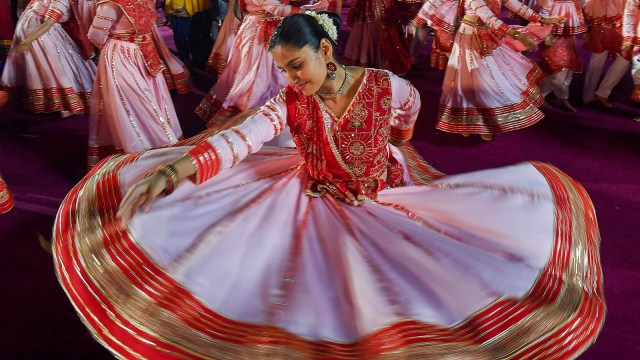📣 For more lifestyle news, click here to join our WhatsApp Channel and also follow us on Instagram
A dance through time with garba, from village squares to party plots
What began as a sacred dance in forgotten courtyards has now blossomed into a celebration that pulses through the cities and villages of modern India, carrying with it the whispers of the past.
 Garba has always been a dynamic art form, shaped by the era and the people who perform it (PTI photo)
Garba has always been a dynamic art form, shaped by the era and the people who perform it (PTI photo)In the heart of Gujarat, under the soft glow of oil lamps, an ancient rhythm stirs. Feet tap the earth in reverent circles, hands clap in unison, and the air hums with songs passed down through generations. This is garba, a dance that has transcended time and changes like the seasons, constantly evolving yet always rooted in timeless devotion to the divine feminine.
What began as a sacred dance in forgotten courtyards has now blossomed into a celebration that pulses through modern India, carrying the whispers of the past.
Mythological beginnings: The influence of Mahabharata
Garba’s origins can be traced back to the epic Mahabharata, according to Gujrati culture expert and author Himanshu Raval.
Arjuna, during the last year of exile, disguised as Bruhannala, a eunuch, and learned women’s harem dance — hallisaka — a circular movement symbolising life, birth, and rebirth. This early dance mirrored the universe itself.
 A dance group from Ahmedabad performs full dress garba practice at a village themed restaurant in Paldi ahead of Navratri festival (Express photo by Bhupendra Rana)
A dance group from Ahmedabad performs full dress garba practice at a village themed restaurant in Paldi ahead of Navratri festival (Express photo by Bhupendra Rana)
The word “garba” comes from “garbha,” meaning womb — a vessel of life. At the dance’s centre, a glowing diya (lamp) in a matka (pot) symbolises creation and the boundless energy of the mother goddess. Life is celebrated, sustained, and honoured in these sacred circles.
Over time, Lord Krishna popularised this dance, which evolved into “rasa,” where men performed with sticks in honour of the deity. In the past 150 years, Garba, as we know it today, emerged, integrating masculine (rasa) and feminine (garba) energies.
Cultural evolution: From tradition to innovation
Garba is dynamic, shaped by its performers and the times. Professor Dr Parul Shah, former dean of the faculty of performing arts at The Maharaja Sayajirao University, Baroda, explained dancing in circles has been a universal human tradition since time immemorial, symbolising the cyclical nature of life.
The Garba circle, with clapping hands and turning feet, mirrors the earth’s rhythms and the seasons. The diya represents the spark of life, the womb of creation and the energy that sustains life.
View this post on Instagram
Historically, women performed garba in devotion to the mother goddess, while men performed a related form called garbi. These dances, performed in town squares and sacred spaces, fostered a deep sense of community. Over time, modern choreography, lighting, and large-scale performances transformed the tradition. The advent of performing garba in “party plots” is a modern twist on this ancient practice.
According to Mahendra Andani, who has run Shree Patel Ras Mandali for 43 years, garba has become more commercial over the last decade. However, he believes that this evolution is natural as long as the devotion and respect for tradition remain intact. Garba today is a mix of the old and new.
Modern-day garba: Blending tradition and contemporary trends
As garba evolves, it embraces modern influences without losing its traditional roots. Shreya Adeshara, fashion designer at Cotoresha, said that today’s Navratri celebrations mix Bollywood beats and innovative moves like the “zombie step” while maintaining traditional values. This evolution also extends to garba attire, she says, with modern chaniya cholis combining traditional craftsmanship with contemporary designs, often using sustainable fabrics.
 Even in today’s fast-paced world, some traditions—like dancing barefoot—are preserved, grounding the dancers to the earth beneath them (Express archive photo)
Even in today’s fast-paced world, some traditions—like dancing barefoot—are preserved, grounding the dancers to the earth beneath them (Express archive photo)
Ritika Solanki Makwana, a garba teacher, stressed the spiritual aspect of the dance. At her school, Navtaal Garba, they start with traditional two-taali and three-taali steps to connect with ancient roots before incorporating modern elements. “We may embrace new trends, but we never let go of the roots,” she said. Some traditions, like dancing barefoot, are still preserved, grounding dancers to the earth.
The essence remains preserved
At its heart, garba is a form of worship and a way for communities to come together. Elaborating on the circle in garba, Dr Shah said it represents oneness, with each dancer moving individually while being part of a larger, universal rhythm. This symbolism remains timeless, even as garba evolves.
As we perform garba today, our feet trace the same circles as they did millennia ago. In that timeless motion, we connect not only with each other but with the generations who came before us and those who will follow.
📣 For more lifestyle news, click here to join our WhatsApp Channel and also follow us on Instagram


Photos



- 01
- 02
- 03
- 04
- 05






















